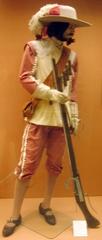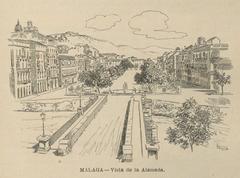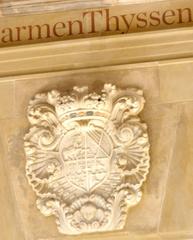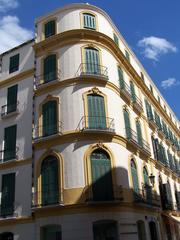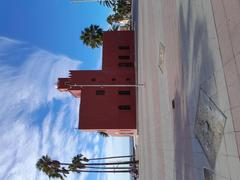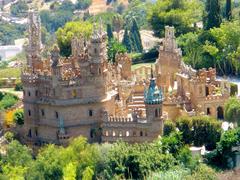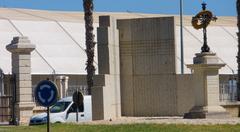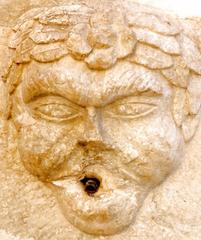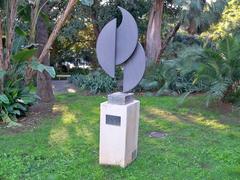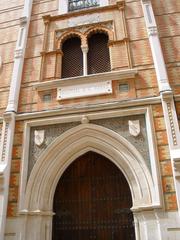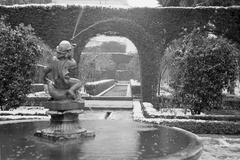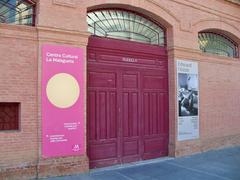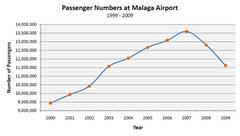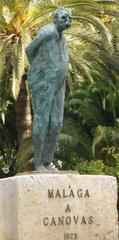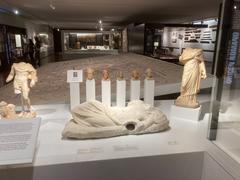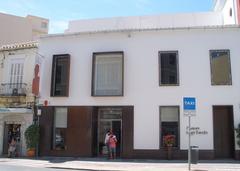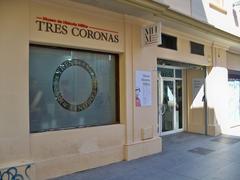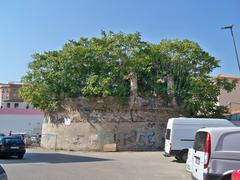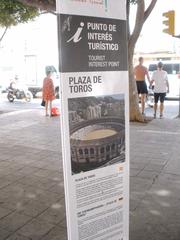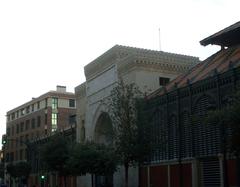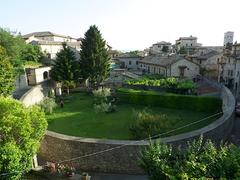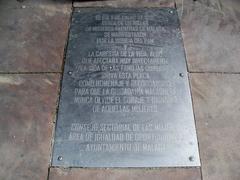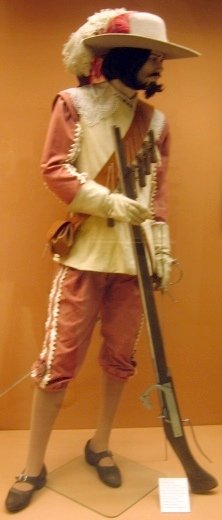
Visiting Castillo de Gibralfaro: Tickets, Hours, and History
Date: 17/07/2024
Introduction
Perched atop Monte Gibralfaro, overlooking the vibrant city of Málaga, the Castillo de Gibralfaro is an enduring symbol of Spain’s diverse and tumultuous history. This majestic Moorish fortress, with its imposing walls and panoramic views, offers a captivating glimpse into a bygone era marked by conquests, sieges, and cultural blending. From its Phoenician roots to its pivotal role during the Reconquista, the Castillo de Gibralfaro stands as a testament to the strategic and architectural prowess of its builders. Whether you’re a history enthusiast eager to delve into the fortress’s storied past or simply looking to enjoy breathtaking vistas of Málaga and the Mediterranean, this guide will provide all the essential information you need to plan a memorable visit. For further details, you can check the official EMT Málaga website for transportation details and the Mijas Taxi website for ticket prices.
Table of Contents
- Introduction
- Historical Background and Significance
- Visitor Information
- Travel Tips and Nearby Attractions
- Accessibility
- Conclusion
- FAQ
Historical Background and Significance
Phoenician Origins and Roman Expansion
The history of Gibralfaro Hill dates back to the Phoenicians, who, recognizing its strategic importance, established a settlement and lighthouse here around the 8th century BC. The name “Gibralfaro” itself is believed to have originated from this period, derived from the Phoenician “Jebel-Faro,” meaning “Mount of the Lighthouse.”
Later, during the Roman conquest of the Iberian Peninsula, the hill was incorporated into the Roman municipality of Malaca (present-day Málaga). While the Romans recognized the strategic value of the hill, they did not undertake significant fortifications, focusing instead on developing the port city below.
The Rise of the Moorish Fortress
The construction of the fortress we see today began in the 10th century AD under the rule of Abd-ar-Rahman III, the Caliph of Cordoba. Recognizing the need to fortify Málaga against increasing threats from Christian kingdoms to the north, Abd-ar-Rahman III ordered the construction of a defensive enclosure encompassing the entire summit of Gibralfaro Hill.
The fortress was further expanded and strengthened in the 14th century by Yusuf I, the Sultan of Granada. He built the double walls that connect the Castillo de Gibralfaro to the Alcazaba, another Moorish fortress located downhill, creating a formidable defensive complex that proved nearly impregnable.
The Reconquista and Beyond
The Castillo de Gibralfaro played a pivotal role during the Reconquista, the centuries-long Christian reconquest of Spain. In 1487, the Catholic Monarchs, King Ferdinand II of Aragon and Queen Isabella I of Castile, laid siege to Málaga, marking one of the final stages of the Reconquista.
The siege of Málaga lasted for three grueling months. While the Alcazaba fell relatively quickly, the Castillo de Gibralfaro, under the command of the valiant Moorish leader Hamet el Zegrí, held out fiercely. The fortress’s strategic location and robust defenses posed a significant challenge to the besieging Christian forces.
Eventually, facing starvation and dwindling supplies, Hamet el Zegrí surrendered the Castillo de Gibralfaro to Ferdinand and Isabella on August 18, 1487. Legend has it that Ferdinand raised his own banner on the Torre del Homenaje (Homage Tower), the highest point of the fortress, signifying the end of Moorish rule in Málaga.
From Military Stronghold to Historical Treasure
Following the Reconquista, the Castillo de Gibralfaro continued to serve as a military stronghold, albeit under Christian control. It underwent several renovations and modifications to adapt to evolving military strategies and weaponry. However, with the passage of time and the diminishing threat of invasion, the fortress gradually lost its strategic importance.
In the 19th century, the Castillo de Gibralfaro was declared a National Monument, recognizing its historical and architectural significance. Today, meticulously restored and maintained, it stands as one of Málaga’s most popular tourist destinations, offering visitors a captivating journey through time.
Significance of Castillo de Gibralfaro
The Castillo de Gibralfaro holds immense historical and cultural significance, representing a confluence of civilizations and a pivotal period in Spanish history.
- Military Architecture: The fortress exemplifies Moorish military architecture, showcasing advanced engineering techniques and strategic design elements. Its double walls, fortified towers, and strategic placement on the highest point of the hill highlight the military prowess of its builders.
- Symbol of Resistance: The Castillo de Gibralfaro stands as a symbol of Moorish resistance against the advancing Christian forces during the Reconquista. The three-month siege it withstood is a testament to the fortress’s strength and the determination of its defenders.
- Historical Landmark: As one of the last Moorish strongholds to fall during the Reconquista, the Castillo de Gibralfaro marks a turning point in Spanish history, signifying the end of Moorish rule in Málaga and the consolidation of Christian power in the region.
- Cultural Heritage: The fortress represents a fusion of Moorish and Christian influences, reflecting the cultural exchange that occurred in Málaga over centuries. Its architecture, artifacts, and historical narratives offer valuable insights into the city’s diverse past.
- Panoramic Views: Beyond its historical significance, the Castillo de Gibralfaro offers breathtaking panoramic views of Málaga, the Mediterranean Sea, and the surrounding mountains. The views from its ramparts and towers are truly awe-inspiring, providing a unique perspective on the city’s beauty and strategic location.
Visitor Information
Opening Hours
The Castillo de Gibralfaro is open to visitors every day. Opening hours may vary seasonally, so it is advisable to check the official website for the most current information.
- Summer (April to October): 9:00 AM - 8:00 PM
- Winter (November to March): 9:00 AM - 6:00 PM
Ticket Prices
Tickets can be purchased at the entrance or online in advance. Prices are as follows:
- Adults: €3.50
- Children (under 16): Free
- Seniors (65+): €1.50
- Combined Ticket (Castillo de Gibralfaro + Alcazaba): €5.50
Guided Tours
Guided tours are available for visitors who wish to learn more about the historical and architectural significance of the fortress. These tours can be booked through the official website or at the entrance.
Travel Tips and Nearby Attractions
Best Times to Visit
The best times to visit the Castillo de Gibralfaro are during the early morning or late afternoon to avoid the midday heat and large crowds. The views during sunset are particularly spectacular.
How to Get There
The fortress is accessible by foot, car, or bus. A scenic walk through the Paseo Don Juan Temboury will lead you to the entrance. Alternatively, you can take bus number 35 from the city center.
What to Bring
- Comfortable walking shoes
- A hat and sunscreen
- Water and snacks
- A camera for capturing the stunning views
Nearby Attractions
- Alcazaba: A Moorish palace and fortress located downhill from the Castillo de Gibralfaro.
- Roman Theatre: An ancient Roman theatre situated at the foot of the Alcazaba.
- Málaga Cathedral: A majestic Renaissance cathedral in the heart of the city.
- Picasso Museum: A museum dedicated to the works of Pablo Picasso, who was born in Málaga.
Accessibility
The Castillo de Gibralfaro strives to accommodate all visitors. While the fortress is located on a hill, there are pathways and ramps to assist visitors with mobility issues. Accessible restrooms and parking are also available.
Conclusion
Today, the Castillo de Gibralfaro stands not only as a reminder of Málaga’s past but also as a symbol of its resilience, cultural richness, and enduring spirit. It serves as a bridge between centuries, inviting visitors to explore the layers of history embedded within its walls and to appreciate the panoramic beauty that captivated civilizations for millennia. Plan your visit and immerse yourself in the captivating history and breathtaking views that the Castillo de Gibralfaro offers.
FAQ
Q: What are the visiting hours for Castillo de Gibralfaro?
A: The Castillo de Gibralfaro is open every day. Summer hours are 9:00 AM - 8:00 PM, and winter hours are 9:00 AM - 6:00 PM.
Q: How much are the tickets for Castillo de Gibralfaro?
A: Tickets are €3.50 for adults, free for children under 16, and €1.50 for seniors 65+. A combined ticket for Castillo de Gibralfaro and Alcazaba is €5.50.
Q: Are guided tours available?
A: Yes, guided tours are available and can be booked through the official website or at the entrance.
Q: What are some nearby attractions?
A: Nearby attractions include the Alcazaba, Roman Theatre, Málaga Cathedral, and the Picasso Museum.
Q: Is the Castillo de Gibralfaro accessible for visitors with disabilities?
A: Yes, the fortress has pathways and ramps to assist visitors with mobility issues, as well as accessible restrooms and parking.
References
- EMT Málaga. (n.d.). Official Website
- Mijas Taxi. (n.d.). Prices and Schedules
